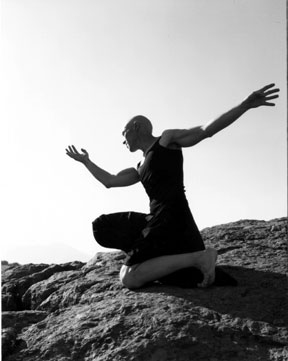A Good Idea Going Nowhere
“The Water Bearers”
Medicine Wheel Dance Project
Noh Space
San Francisco, California
July 12, 2004
By
Rita Felciano
copyright
© 2004 by Rita Felciano
published July 19, 2004
 When
Yuriko Doi started Theatre of Yugen twenty-five years ago, she meant her
theater on the south end of the Theater Artaud complex to be a focal point
for Noh drama and Kyogen comedy and performance works which reflect traditional
and contemporary Japanese and Japanese American culture. Artaud is gone,
but Yugen is still thriving. As a matter of fact, Yugen recently was honored
with a Bay Area Theater award. Over the last quarter of a century years,
the company has performed both traditional Japanese theater and interpreted
such Western classics as “Frankenstein”, “Blood Wedding”,
“Waiting for Godot”, “Medea” and “A Christmas
Carol.”
When
Yuriko Doi started Theatre of Yugen twenty-five years ago, she meant her
theater on the south end of the Theater Artaud complex to be a focal point
for Noh drama and Kyogen comedy and performance works which reflect traditional
and contemporary Japanese and Japanese American culture. Artaud is gone,
but Yugen is still thriving. As a matter of fact, Yugen recently was honored
with a Bay Area Theater award. Over the last quarter of a century years,
the company has performed both traditional Japanese theater and interpreted
such Western classics as “Frankenstein”, “Blood Wedding”,
“Waiting for Godot”, “Medea” and “A Christmas
Carol.”
For dance watchers Yugen’s monthly series of experimental dance, both from local and visiting artists, has proved to be a real boon, providing opportunities for seeing work simply not available anywhere in the area. Their batting average in nosing out intriguing people from around the country is excellent. Artists such as Michael Sakamoto (Los Angeles) and Haruko Nishimura and Degenerate Art (Seattle) and Roko Kawai (Philadelphia) made their first appearance at the tiny Noh Space.
For local performers, many of them Butho-inspired—Hiroko and Koichi Tamano, Shinichi Momo Koga—Noh Space serves as a place to try out material or present small scale pieces which might end up in a bigger program later on. But last year Winston Tong, who had made something of a splash in the early nineties, all of a sudden re-emerged with a haunting solo on a Jean Genet poem.
This past week John Doyle’s Medicine Wheel Project took the July spot of this special anniversary season line-up of “favorite artists from over the years.” Unfortunately, “The Water Bearers—a Butoh based dance” was not an occasion for celebration.
Doyle claims as inspiration “Japanese Butho dance, Native American spirituality and the landscape of the American West.” Both a dancer and a body work practitioner, Doyle intrepidly treads into the unstable territory between ritual and performance. According to the program notes, “Water Bearer’s” nine distinct episodes attempt to create a connecting tissue between the essential fluidity of life and life’s origin in water. Though a huge idea and maybe not the most original, it is a plausible concept for a choreography.
But in order for movement to reach beyond the performer, it has to be individualized enough to transcend beyond the commonplace and come through a vessel that is pliable, expressive and nuanced. No doubt, Doyle felt deeply about every pedaling head stand, every wafting arm, every crouched hop, but they were so blandly executed that they didn't tell us anything. This was as true for his own choreography as it was for that for his four dancers. There it seemed to consist primarily of a set of musical cues to which the minimally trained dancers then improvised.
Too much of “Water Bearers” reminded one of what Mark Morris once said. “It doesn’t mean we want to see it, just because you want to do it.” Morris was not trying to be condescending or snide, he simply made a point about the stage not being primarily a place for self-expression but a place for presentation of something.
Several of the episodes had seeds to them that could have been grown into something: a series of rises into verticality with accompanying in and exhaling breaths in ‘Wind on the Water’ ; a set of duets which, however, went nowhere in ‘At the Shore’, and the dissonant crouching and fetal movements in ‘Conception Vessel.’
Only once did the piece come alive. ‘Reflecting Pool’ featured Dohee Lee in a solo with a distinct push and pull quality to it that made a counterpoint against more fluid movements. The contrast between that and the rest of the piece was so striking that one suspects that she choreographed it herself.
If Doyle had used better trained performers, and had spent as much care on the choreography as was invested in the richly variegated sound score (by Eric Chaffin) and the additional music by a number of composers, he might have had a work in which not only the music flowed beautifully but the dances might have as well.
John Michael Doyle in "The Water Bearers." Photo: Michael Callahan.
Originally
published:
www.danceviewtimes.com
Volume 2, No. 27
July 19, 2004
Copyright
©2004 by Rita Felciano
|
|
|